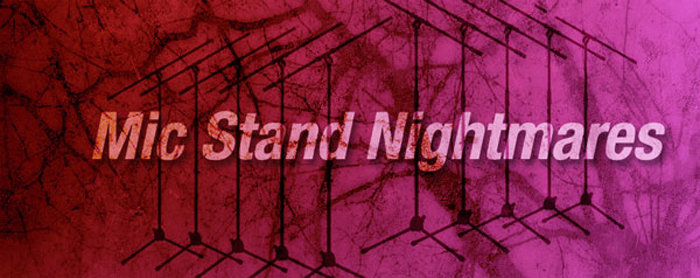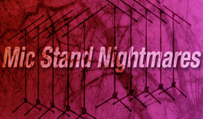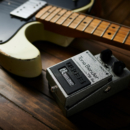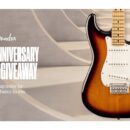
There’s a piece of equipment almost all singers use which I used to take for granted. That is, until I had a series of mishaps with it that disrupted my performance and shattered my swagg. Since that period of trials and tribulations, I began watching other singers and discovered that I was not alone.
Nowadays it’s pretty common knowledge: If you are a singer you’ll need to use a microphone. There is such a thing as good and bad mic technique; but what about the mic stand? I never knew there was anything to know about this slender metallic object upon which my mic perched, until…
How Low Can You Go?
Many years ago at the start of one of my early concerts, I entered the stage to a cheering crowd in a packed venue. My strategy was to begin singing with the mic on the stand so that my arms were free to gesture. Then, at a particularly dramatic section of the song, I planned to grab the mic off the stand and begin moving across the stage.
The band began their intro of our opening song. Entering from back stage and illuminated by the glow of the follow-spotlight, I could see my mic on the mic stand awaiting my arrival. But as I reached to grab it, I suddenly realized I had been wearing sneakers during sound check and––now wearing 3-inch heels––the mic stand height was too low!
Instead of being able to stand stage center, dramatically poised and ready for my vocal entrance, I now needed to adjust the stand so I could sing into the mic without stooping. I reached for the height adjustment device on the mic stand—the kind that you have to turn. The stagehand had screwed it so tightly I couldn’t get it to budge. Gone was my original plan for a dramatic and seamless show opening as I grasped the stand trying without success to get that knob to turn. And before I could do anything more, there was the musical cue for me to start singing.
Lessons Learned
When using a mic stand with knob adjustments, during sound check test the mic stand adjustments and make sure the knobs are not turned too tightly. Also, position the mic stand height for the shoes I’ll be wearing for the show. FYI: I found two companies that make singer-friendly mic stands designed to eliminate the problems associated with ordinary stands: Hercules Stands and DR Pro Quick Release Microphone Stands. Both are constructed with one-hand squeeze triggers—no knobs.
London Bridges Falling Down
I like designing the energy of my set list to develop in intensity. Grabbing the mic off the stand at peak moments can add energy, so I work that into facets of my shows. One night while performing in London some years ago, by the third song we really began to rock out. I grabbed my mic intending to take it off the stand, but the cord was wound so intricately that the whole stand fell over disconnecting the mic from the cord!
Note to Self: Before a performance that uses a corded mic, always make sure the cable is NOT wound around the stand. Note to Self: Tell the sound engineer that you are intentionally keeping it that way so that he does not wind it before you go on. (Sound engineers commonly think this is the preferred thing to do with mic cables.)
Swing Low, Sweet Chariot
Usually I sing out in front of the band, but occasionally I accompany myself on piano. During one such performance on a ship in the Caribbean, I was seated at their grand piano with the mic on a tripod (3-legged) boom stand. Everything during sound check was totally fine, but during the show the mic slowly but surely drifted downwards toward the keyboard. The mic stand had a defective gear, so every time I was able to take a hand off the keys and raise the boom it would not hold and drifted down once again.
More Lessons Learned
Always double check the knobs on any mic stand and make sure the gears are not stripped. FYI: When needing to adjust a mic stand height, always unscrew the knob first, then raise or lower it, then tighten the knob to lock the position in place.
I remember the first time I realized that a mic stand is only helpful if it has a mic clip on it. You know, one of those “duh” moments. Here are a couple of mishap stories that make the point:
A House is Not A Home
I brought my own brand new and “perfect-for-my-voice” mic to my show. When I went to place it on the mic stand provided by the venue, I found that the size of their mic clip was too small for my mic. So, I had to enter the stage holding the mic and continue to do so throughout the entire show.
You’ve Really Got A Hold On Me
Then there was the gig where I had no sound check and both the mic and mic stand were supplied and set up for me by the soundman. Ready to start moving around the stage, I reached for the mic to take it off the stand. I literally could not get it to budge. The mic clip had a death grip!
Note to Self: Bring my own mic clip, appropriate in size for my personal mic. Note to Self: Use an easy-on / easy-off flexible clip which allows the mic to be popped on and off from the top with great ease.
Knowledge is Power
Perhaps now that I’ve brought all this up, you’ll begin noticing things you can do to use—rather than be abused by—mic stands. I’ve developed strategies to gain control over them to ensure they don’t distract from my performances. And whenever possible, I bring my own mic, mic clip and mic stand to my gigs.
This article is adapted from a chapter of the eBook: Singer’s Guide to Powerful Performances by Jeannie Deva.












